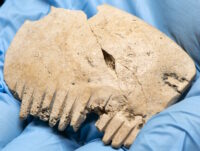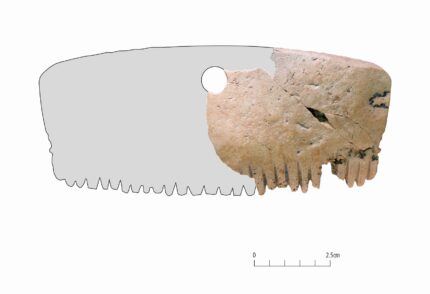 A fragment of an Iron Age comb discovered during highway construction has been identified as a rare example of a bone comb carved from a human skull, one of only three known. The comb was unearthed at Bar Hill near Cambridge, the site of an Iron Age settlement where the unprecedented mass burial of 8,000 frog bones was discovered in the same archaeological excavation. In three years of excavation at Bar Hill, archaeologists recovered 280,000 remains and artifacts. Since the dig ended in 2018, Museum of London Archaeology (MOLA) researchers have been going through the immense backlog of Bar Hill objects, which is why it has taken this long to analyze the comb and identify it as a carved piece of human skull.
A fragment of an Iron Age comb discovered during highway construction has been identified as a rare example of a bone comb carved from a human skull, one of only three known. The comb was unearthed at Bar Hill near Cambridge, the site of an Iron Age settlement where the unprecedented mass burial of 8,000 frog bones was discovered in the same archaeological excavation. In three years of excavation at Bar Hill, archaeologists recovered 280,000 remains and artifacts. Since the dig ended in 2018, Museum of London Archaeology (MOLA) researchers have been going through the immense backlog of Bar Hill objects, which is why it has taken this long to analyze the comb and identify it as a carved piece of human skull.
It is an end piece of a rectangular comb with rounded edges and short, thick teeth roughly cut that they are separated from each other at the tips. There is no wear on the teeth on the comb, which there would have been had it been utilized as a tool, either for combing hair or in the manufacture of textiles. It did have a hole drilled in the middle (a semi-circular edge of the perforation is visible on the top left of the fragment), which suggests it may have been worn as an amulet instead of employed for practical purposes.
The other two skull bone combs were discovered very close by: one in Earith, nine miles north of Bar Hill, the other at Harston Mill, 10 miles to the south. For the only three skull combs ever discovered to be located in such close proximity to each other suggests this have been a regional or local practice exclusive to the area.
Conversations between Michael Marshall and MOLA Osteologist (human bone expert), Michael Henderson, also sparked a new theory. It is possible the teeth of the comb could represent the natural sutures that join sections of the human skull.
Michael Marshall explains further:
“These carved teeth and lines would have highlighted the Bar Hill Comb’s origin, especially for local Iron Age communities who were familiar with skeletal remains. It’s symbolism and significance would have been obvious to anyone who encountered it.”
Instead of being just a practical tool, the Bar Hill comb may have been a powerful object for members of the local Iron Age community. Perhaps the skull belonged to an important person, who continued to play a role in the community even after their death.
When analyses of the Bar Hill Comb are complete, it will find a permanent home at the Cambridgeshire Archaeology Archive.

“It is possible the teeth of the comb represent the natural sutures that join sections of the human skull. These carved teeth would have highlighted the Bar Hill Comb’s origin, especially for local Iron Age communities who were familiar with skeletal remains. It’s symbolism and significance would have been obvious to anyone who encountered it.”
– ?!? – 💀️
If these human skull combs are a local “phenomenon”, wouldn’t it also be “possible” that a local “do-it-yourselfer” slew 24 of his enemies, found a way to make these combs and then gave them away as a present at a local gathering?
“REDUCE, REUSE, RECYCLE!” – It is also highly “possible” that a tradition of “human skull combing” simply came into fashion, after they had to get rid of all their “skull drinking cups” from the previous season.